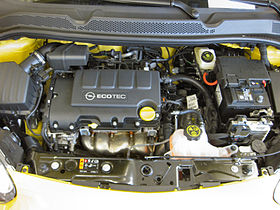| Family 0 | |
|---|---|
 Family 0 engine in an Opel Adam | |
| Overview | |
| Manufacturer | General Motors |
| Also called | Family Zero |
| Production | 1996–present |
| Layout | |
| Configuration | Straight-3, Straight-4 |
| Displacement |
|
| Cylinder bore |
|
| Piston stroke |
|
| Cylinder block material | Cast iron |
| Cylinder head material | Aluminium |
| Valvetrain | DOHC 4 valves x cyl. with VVT |
| Compression ratio | 9.5:1, 10.1:1, 10.5:1 |
| Combustion | |
| Fuel system | Sequential MPFI |
| Fuel type | Gasoline, E85 |
| Oil system | Wet sump |
| Cooling system | Water-cooled |
| Output | |
| Power output | 55–140 PS (40.5–103 kW) |
| Torque output | 82–220 N⋅m (60–162 lb⋅ft) |
| Chronology | |
| Predecessor |
|
| Successor | Small Gasoline Engine |
The Family 0 is a family of inline piston engines that was developed by Opel, at the time a subsidiary of General Motors, as a low-displacement engine for use on entry-level subcompact cars from Opel/Vauxhall.
These engines feature a light-weight cast-iron semi-closed deck engine block with an aluminum cylinder head. The valvetrain consists of chain-driven hollowcast dual overhead camshafts (DOHC) that actuate 4-valves per cylinder via roller finger followers with hydraulic tappets. These engines also feature a 78 mm (3.1 in) bore spacing and fracture-split connecting rods.
Later versions also incorporate a variable length intake manifold (VLIM) and variable valve timing (VVT).
Originally debuting as either a 1.0 L (973 cc) straight-3 or 1.2 L (1,199 cc) straight-4; a 1.4 L (1,364 cc) I4 variant was added with the introduction of the second generation, replacing the 1.4 L Family 1 engine. The Family 0 engines were produced by Opel Wien in Vienna/Aspern (Austria), by GM in Bupyeong (Korea) and Flint (Michigan, USA).
